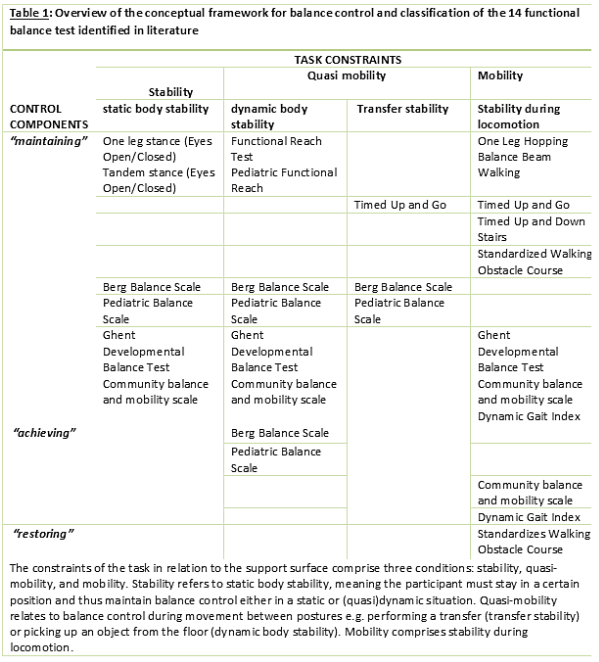Adequate balance control is a prerequisite for normal motor development. In children showing motor or developmental problems, identifying balance control problems is often the first step towards monitoring and rehabilitation. However, a universal definition of balance control is lacking in literature despite ample interest in the concept of balance over the past 30 years. Defining a complex and multifaceted skill like balance control is indeed not an easy task. In clinical practice, numerous tests are available to measure balance in children but not all are able to assess all aspects of this complex skill. The lack of a clear definition of balance control and the wealth of balance tests used in clinical practice highlight the need for an adequate assessment tool.
To provide an overview of balance measurement tools and functional balance tests used in children, we performed a literature search in PubMED and Web of Science. We described the psychometric properties of the available tests and, to highlight the different aspects of balance control, we defined a conceptual framework combining different views on balance control. This conceptual framework is not a definition of what balance control is, but rather provides a framework to classify available tests according to the ‘balance control components’ and ‘task constraints’ that the test assesses (see table 1). A total of 14 functional balance tests were identified. By categorizing these tests in our conceptual framework, it became clear that no single balance measure could independently comprehend the total concept of balance control. Our results further suggest that static and dynamic balance control are part of the same construct, but the extent to which both aspects of balance control contribute to the performance on a given task appears to depend on the task constraints.
Our overview has clear clinical implications. In clinical practice, a combination of tests is recommended, paying attention to postural control in both static and dynamic situations and under different task constraints. Our literature search reveals that a test for children that is able to evaluate reactive mechanisms to balance perturbations is lacking. Furthermore, our literature study suggests that it is necessary to establish a criterion standard to measure balance in children. Such a criterion would allow to further investigate structural validity and responsiveness of the existing tests.

Publication
Psychometric properties of functional balance tests in children: a literature review. Verbecque E, Lobo Da Costa PH, Vereeck L, Hallemans A. Dev Med Child Neurol. 2015 Jun;57(6):521-9. doi: 10.1111/dmcn.12657
About the Author

Prof. dr. Ann Hallemans
Rehabilitation Sciences and Physiotherapy, Faculty of Medicine and Health Sciences, University of Antwerp
Prof. dr. Ann Hallemans, department of Rehabilitation Sciences and Physiotherapy, Faculty of Medicine and Health Sciences, University of Antwerp, Antwerp, Belgium
In 2005 I obtained a PhD in Sciences studying the biomechanics of early walking. Currently, I am a research professor at the department of Rehabilitation Sciences and Physiotherapy and chairman of the M²OCEAN movement analysis lab at the Antwerp University Hospital. My research focuses on neuromechanics and balance control in relation to childhood development.
Copyright
© 2018 by the author. Except as otherwise noted, the ISPGR blog, including its text and figures, is licensed under a Creative Commons Attribution-ShareAlike 4.0 International License. To view a copy of this license, visit https://creativecommons.org/licenses/by-sa/4.0/legalcode.
ISPGR blog (ISSN 2561-4703)
Are you interested in writing a blog post for the ISPGR website? If so, please email the ISGPR Secretariat with the following information:
- First and Last Name
- Institution/Affiliation
- Paper you will be referencing
